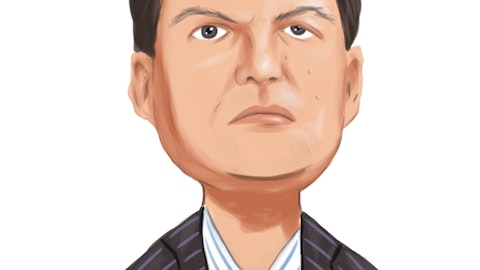Synergies, as you called out, are also another important tailwind for us. That’s something that is developed very nicely. And this year, well, I think I’m confident we’ll pass the EUR 8 billion mark in terms of how that runs into our numbers. So, that is something that is – I think that answers that question for you. TPC is also something that’s very important for us in terms of that number moving in the right direction and everything we can control there. When it comes to the Middle East and Africa, could you repeat your question for me? It was something about volumes.
Michael Jacks: Yeah, I mean, we discussed in the previous question about price and mix, but obviously, volumes have been a significant headwind – I mean, tailwind, sorry, a massive tailwind. Should we expect some degree of moderation here next year? Or does your level of visibility suggest that this kind of volume level can be sustained for the next, say, three to six months?
Natalie Knight: Yeah. I think in terms of 2024 outlook, you can expect us to talk about that a lot more when we have the full year results. But it’s really going to depend on what’s happening in the market conditions there. I think if you look at our business in the Middle East and Africa, we have some core things that are going our way in terms of we have a very strong position in the Turkish market, and we’ve continued to build on that. We have the new entry into Algeria, which is something where we’ve got outstanding market share and really see continued opportunity. But there definitely is – these are all markets where there are higher volatilities, there are different macro things coming into play. So I’d like to be a little cautious about giving too much guidance on that until we get to our full year numbers.
Michael Jacks: Understood, thank you. And then just quickly circling back on the industrial costs. Should we expect a headwind again in the second half of this year or a more neutral impact?
Natalie Knight: No, I think you should definitely expect a more neutral impact if you’re looking at between now and the end of the year.
Michael Jacks: Thank you.
Operator: Thank you. And we’ll now take our next question from Daniel Roeska of Bernstein Research. Your line is open. Please go ahead.
Daniel Roeska: Hi, good morning, good afternoon. One question on the inventories. They’ve held largely steady as you showed in your presentation from the first half with a slight shift in the channel. May I ask about more medium-term, how would you react with regards to mid-term production volumes if inventories kept going up across your regions in the upcoming months? And then secondly, maybe a broader question, Natalie, could you give us an update on your agenda other than the obviously hot topics of the day, what do you want to be more focused on in the medium-term for Stellantis and where you’d like to leave your mark? Thanks.
Natalie Knight: Great. Thank you. Two questions there. The first one was on inventories. And I think this has been a topic – I know we’ve been getting some calls on it during the day. So maybe a little more color on that one as well, which is, if we look at the inventory levels, I think I called out in my prepared comments that we’re very pleased that in Europe, we started to see things move the right way, that we’ve had logistics improvements. You know this has been a place we’ve been working on. We’re starting to see that pay off. Conversely, that means that we still have levels in America that are higher than what we would like. And I think this is something where there is a piece that I commented on, which is, of course, because of the strike, we had been very thoughtful about how do we ensure we have the right levels to ensure that we give continuity to our customers.
There were a couple of other items that played into our inventory numbers when we look at Q3 that I do think like the strike number will abate as we go forward. The first one was really about planned downtimes that we’ve got in terms of our plant facilities. It was for the challenger and the charger at Dodge, where we’re looking at getting those to be more electrified future. And the same thing with our Chrysler Pacifica. So, that’s something that I think is very important in terms of just sort of understanding why we’re there and also why we believe we will see some inventory improvement as we go towards the end of this year. And when you look at the question of more medium-term in terms of how we think about it, well, obviously, the inventories are going to depend on our sales evolution and how that moves.
And our expectation is that we will see our sales improve. We have new models coming to market. We’ve got a lot of exciting products in terms of on the EV side in the US. And that’s a place where that’s what helps us to get our numbers where they ought to be in terms of inventory. And what we’re really doing is, we’re thinking about constantly how do we optimize the day of sales figure. It isn’t where we want it to be yet in North America. And obviously, over time, if it isn’t where it needs to be, then we’ll take corrective action. But I do believe at the moment, we’ve got a good plan in terms of the products so that the flow of cars that are coming out that we will be able to show progress there and feel confident about the development going forward.





